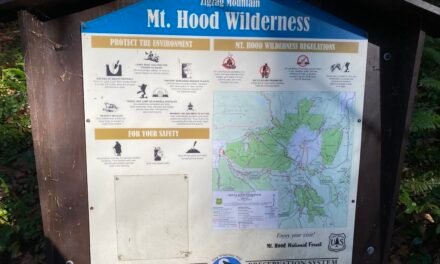2020 has been generally a pretty shitty year – even though I managed to get in some quite spectacular hiking. However, after my Timberline Trail hike, I started to feel some pain in my right big toe. Although it’s not a severe pain, it became a more nagging annoyance. So right at the end of the year I dropped into the doctor’s office and got, a non-surprising diagnosis of hallux limitus/rigidus, a great way to end the 2020 hiking season.
I kinda new that this was what the issue was – Google has become pretty good at providing information to help self-diagnose yourself, as long as you can discard some of the more alarmist answers. Here’s the quick pack story and what I am going to do moving forward to try to not let this change my hiking goals.
(As an update you can see how the surgery went!)
Actual Appointment
There really wasn’t much prep necessary for the visit. They warned me that I needed to get there early as they might need to take some X-rays. Being in the middle of the holiday season – I was actually early for once. In spite of the current Covid protocols, the check-in procedure was pretty simple. As expected they wanted to take a couple of X-rays. They took three of these from different angles – in total that took another 10 minutes.
You can see the full details of each of the X-Rays by clicking on the pictures to see the full image.
Meeting with the Doctor
My local medical provider is OHSU – which is also a teaching hospital. This often means that you get to see a resident in training and then the doctor. I’m pretty used to this procedure and so I spent the first couple of minutes with the resident. Portland, being quite an outdoorsy city, I lucked out with a resident who was also a hiker. After the obligatory initial chit chat, he looked at the X-Rays and said ‘oh yes hallux limitus, you have all the 4 typical signs of it”. He kindly pointed out the bone spurs and the narrowing of the joint space. Outside of that joint, he was pretty happy with the rest of the way my foot looked. The attending doctor came in and pretty much confirmed everything that the resident had said. She indicate that this was a stage 2 case, and went through the treatment options.
Treatment Options for hallux limitus/rigidus
The problem with hallux limitus and its more serious brother hallux rigidus is that it’s degenerative. There is nothing that is going to get better and it’s only going to get worse over time. There is no real clue as to what causes it, whether it was a previous injury or bad foot ware. The options the doctors went through basically went from more conservative to more aggressive, with a general understanding that it‘s going to progress over time.
- Initial pain can be managed with over the counter pain medications like ibuprofen. The doctors saw this as a viable medium term option, although they said that if this became a chronic need I should have kidneys checked regularly as there is a potential long term impact.
- The basic strategy to manage the joint in the medium term is to enable walking by providing more support for the big toe. Their recommendation was to move to a stiffer shoe and look into a Morton’s Toe insert. This would provide for continued ability to hike but without the need to have the MTP joint bend as much and reduce the stress on the joint.
- The longer term interventions involve surgery and there were basically two options here. The first is a cheilectomy This basically removes the bone spurs around the MTP joint and returns some of the range of motion. It can’t repair any of the damaged cartilage, so again it might be a temporary solution.
- The ‘gold standard’ for surgical intervention is arthrodesis, which is the fusion of the bones at the joint. This effectively reduces the range of motion of the joint to zero, but also reduces the pain to zero, walking and hiking is still possible after this.
What does this mean?
Currently, all I get from this is some mild foot pain that seems to be easily treated with Ibuprofen. I currently hike in Altra LPs – these are awesome hiking shoes – they never give me a blister, are super light and flexible. And that’s part of the problem – they are very much a minimalistic shoe and very flexible. There is very little support for the MTP joint and it almost assumes a lot of flexibility in that joint.
After some research online and 2 hours trying on different shoes at REI. I looked for something with a much more supportive sole and stiffer. I ended up liking a pair of Hoka One One Speedgoat’s. The good news is that I could immediately feel the relief they provided to my toe. The bad news is that it‘s a completely different style of shoe – it‘s both a different feel to walking altogether, with a much more rocking motion and the sole is far more cushioning. Overall the shoe feels much more like a regular sneaker and I certainly miss the larger toe box from the Altra’s.
The other option I’m trying is a carbon fiber insole into my Altras. This is just over 1mm thick and slips below the regular insole. The original insole on the Altra is pretty thin and this might create a problem. However the Altra with the carbon fiber insole feels much better than the Speedgoat – for me, it‘s more because it retains the more lightweight feel of the shoe.
How it’s going so far
I’ve taken both out for about a five-mile hike – neither of these has been particularly strenuous. My initial feeling is that the insole option in the LPs works better for me – I just find the shoe overall a little more comfortable. In both cases, it’s not that my toe has become suddenly pain-free and I think this is going to be a key issue. Whether the inflammation will not go down or whether I’ll have to manage some level of pain with Ibuprofen. In that case, I might look at having one of the surgery options sooner rather than later.
All in all a bummer way to end what, after all, was a shitty year. Hopefully, even with hallux limitus/rigidus 2021 will be a better hiking year.
Here’s the link to Part 2.










I’m behind you almost exactly a month. Looking back the condition started probably 30 years ago when I jammed the toe badly hiking on the Everest trek, and of course had to walk out on it. I got Rx orthotics when it continued to bother. That helped a bit, but after awhile I found Superfeet and the like did as well.
Started day hiking the Cascades again 3 years ago. Generally get in 30+ hikes/year. Every year the toe has been getting worse. Saw a podiatrist 2/21 and got pretty much the same news, similar X-ray, similar suggestions.
Just got a pair of Hoka Bondi 7 this week. Definitely different kind of shoe. Not a miracle, but they seem to help. They are for walking only, which I do for general health and to help keep in shape 2-4x/week. Walking 3-4 miles on concrete is about as stressful as 6-8 miles + vertical on a hike. I used to think the primary difference was the concrete vs. dirt. Now I think it may be that my boots have an inherently more rigid forefoot than my street walking shoes. Thus, the Hokas for the street.
Now I’m looking for hiking boots, or maybe supplanting the superfeet insole with a carbon.
There’s a number of them, at least by Amazon search. Which one did you get? How did you choose it? There seems to be a choice of rigidity. Where did you get it-shop or mail order?
Sounds like you are happier with the Altra + carbon insole than the Hoka. If so, that’s a path I may want to investigate before I spend another $150-250.
I ended picking up these https://www.amazon.com/Carbon-Fiber-Insole-Narrow-Insert/dp/B088KMT17K/ref=sr_1_1?dchild=1&keywords=Carbon+Fiber+Insole%2C+Narrow+Shoe+Insert+-+Shoe+Stiffener+Insert+for+Hallux+Limitus%2C+Foot+Arthritis%2C+Fractures%2C+Turf+Toe+-+Alternative+to+Post+Op+Shoe+EU39+260mm+%2810.24+inch%2C+Women%27s+Size+10%2C+Men%27s+9%29&qid=1613181836&sr=8-1 – it was really just based on some research – it seems to help a some. The reason I still like the Altra’s is the wide toe box and the overall lightweight nature of the shoe. The Hoka’s are ok but I tend to use those for week walking the Altra’s at the weekend where I try to get a hike above 10 miles in one of the days. The only complaint with the insole is that the Altra sole is a little thin and that reduces the overall comfort some. I might consider a different insole as well.
I’ve been thinking about getting a Cheilectomy – on the grounds that it looks likely to happen at some point and it might just be better to get it done – but then that’s a pretty expensive operation ($20K is before insurance) and I’m in two minds if I want to try and rush one in and still have time to prep for the JMT. I might just work on some physical therapy until and see how it goes over the season.
Hey Fritz – I decided to go ahead and get the surgery – this was a ‘better to do it earlier’ decision – you can see how it’s going https://hikeit.info/2021/03/13/hallux-limitus-part-2-cheilectomy-surgery/
Just got done reading your other 2 posts. I thought I’d get an email notice if you responded. Apparently not. I’ll check in more often.
Right now my Vasque hiking boots with carbon plate are working satisfactorily. I had some Merrell’s I really liked but they simply did not work with or without the plate. At least a buddy has exactly the same size feet, so he’s going to get a lot of shoes.
Do you know about diclofenac topical gel (Volteran)? Stuff seems to actually WORK? No other topical gel I’ve tried have. They even helped with hip and back pain. Could be useful as you worth through rehab, or in general going forward.
I was using Volteran a little before I decided to have surgery – I also thought I might use it after the wound heals completely to help. The actual amount of pain has been really low – but when I stretch the toe to get ROM there’s definitely some tenderness. The last week has been interesting – after the stitches were removed I was moving around more and that was causing some pain – but now I can put weight on it and get out for walks – I’ll probably write another update in a week.
Saw you pop up in the FB HR page. Your experience should be a benefit to the group. There are far more questions on women’s dress shoes than hiking shoes and related content.
Hopefully you’ll get some benefit also.
My ‘first’ purchase to deal with HR was Hoka Bondi 7. If there is ONE shoe that is continually recommended by physicians and this group it’s the Bondi. I did find it an improvement, but not immediately in love with it. It’s a ‘clunky’ shoe, not my favorite kind.
After a couple hikes in my Vasque hiking boots + carbon plate I find the boots work better than the Bondi. I tried the plate in the Bondi but it did not work well at all. It also failed in my favorite Merrell boots miserably.
Dealing with HR is as much a personal recipe, as a medical process it would seem.
Yes – thanks for the FB page link – there is good some information on that page – I find that I am very attached to my Altra’s – and even thou the Hoka (I have a pair of Speedgoats) are ok – I actually prefer the carbon insole in the Altra’s. For me the carbon insole has been really helpful – here’s the latest update. https://hikeit.info/2021/04/04/hallux-limitus-part-4-great-expectations-recovery/ I am pretty happy with current state – with the insole I feel I can pretty much get back to pretty normal hiking. Now I just need to get some ROM back!
There’s no doubt I could have delayed surgery and gone with different shoes etc – but I also feel that getting done early will give me a greater benefit from the results. I’ll see how that goes.